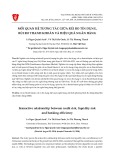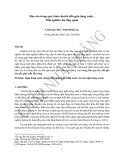
http://www.iaeme.com/IJMET/index.asp 1758 editor@iaeme.com
International Journal of Mechanical Engineering and Technology (IJMET)
Volume 10, Issue 03, March 2019, pp. 1758-1763, Article ID: IJMET_10_03_177
Available online at http://www.iaeme.com/ijmet/issues.asp?JType=IJMET&VType=10&IType=3
ISSN Print: 0976-6340 and ISSN Online: 0976-6359
© IAEME Publication Scopus Indexed
GENDER HETEROGENEITY AND FINANCIAL
PERFORMANCE OF LISTED NIGERIAN
COMPANIES
Adetula, D.T., Owolabi, F., Egbide, B.C. and Adeyemo, K.
Department of Accounting, Covenant University,
Canaan land, Nigeria
ABSTRACT
This study investigated the economic impact of gender diversity on Board
composition of companies listed on the Nigerian Stock Exchange (NSE). Based on the
grouping of fifty most capitalized companies on the NSE into companies with no female
on board and those with at least one female on the board, the firm performance was
analyzed with Mann Whitney U -test over a three-year period. We also examined
whether there was any significant difference between the performance of boards with
only one female and those with more than one female. The results show no significant
difference in the performance of both groups. This is due to moderately heterogeneous
board composition as a result of few females in top level decision-making. We
recommend a policy mandating listed companies to evaluate their employment and
selection methods regarding nomination and promotion into boards and management
teams.
Key words: Economic Performance, Gender Diversity, Nigerian Stock Exchange
Cite this Article: Adetula, D.T., Owolabi, F., Egbide, B.C. and Adeyemo, K., Gender
Heterogeneity and Financial Performance of Listed Nigerian Companies, International
Journal of Mechanical Engineering and Technology 10(3), 2019, pp. 1758–1763.
http://www.iaeme.com/IJMET/issues.asp?JType=IJMET&VType=10&IType=3
1. INTRODUCTION
Nigeria is the most populous country in Africa with one hundred and seventy three million and
six hundred people [1]. Of this number, women account for 49% but grossly under-represented
on the senior executive and board positions in the one hundred and ninety-two (192) firms listed
on The Nigerian Stock Exchange (NSE) as at 2013 [2]. This is however, contrary to developed
world and a few developing world economies that strive to achieve an increased number of
females’ participation in corporate board rooms [3]. Such countries aim at increasing females’
participation because directors in most boardrooms around the world are substantially males.
In order to achieve increase in females’ participation, a number of capital market regulators
have introduced legislations imposing gender quotas or mandatory disclosure of number of
female for boards of listed companies [4].

Adetula, D.T., Owolabi, F., Egbide, B.C. and Adeyemo, K.
http://www.iaeme.com/IJMET/index.asp 1759 editor@iaeme.com
The motivation for the study was aroused from the empirical results of the previous research
studies which are somewhat mixed [5], [6]. Some researchers claim that gender diversity has
positive impact on company by enhancing growth and monitoring process [5],[6],[7] while
others discovered that board gender heterogeneity has no impact on economic performance of
organization [8],[9]. In spite of the importance of equality policies aimed at breaching the gap
and many research associated with gender diversity in the developed world, there is still limited
research on this area in Nigeria. The study fills this gap by evaluating relationship between
gender heterogeneity and company’s performance of listed companies on the NSE.
The sections of the paper are arranged in this order: section two is on literature review and
theoretical background; section three describes research method and section four focuses on
findings, recommendations and policy implications.
2. LITERATURE REVIEW
In the study carried out by [10] in 2013, they claimed there had been scarcity of women
occupying top positions in Nigerian organizations. This prevents their access to and control
over resources which in turn limit women economic independence. Women comprise of greater
part of informal sector workers in Nigeria [11]. The research on gender heterogeneity in Ghana
and Nigeria banking sectors found a wider gender disparity against women [12]. The study of
[13] revealed that women are under-represented in senior management positions.
The results of examination of whether companies governed by female CEOs show the same
performance as companies led by male CEOs reveal that the gender mix of the CEO is crucial
to financial performance of organizations [14]. In addition, the study investigated whether the
gender heterogeneity of the CEO influences the risk level of the firm and if the incentives given
to female CEOs have reduced risky elements compared to those given to their male
counterparts. They found that companies’ risk level is smaller when the CEO is a female
compared to when the CEO is a male. [15] examined the influence of corporate board
characteristics namely board size, board skill, board nationality, board gender heterogeneity,
board ethnicity and CEO duality on the financial performance of Nigerian listed companies
between 1991 and 2008. The study found that board size, CEO duality and gender heterogeneity
have a negative relationship with firm performance. However, the emphasis of this study was
not specifically on impact of gender heterogeneity and profitability of Kenyan banks.
According to [16] who examined the relationship between board gender diversity and
performance of commercial banks in Kenya, both variables have no relationship using banks in
Kenya. The reason attributed to the result was because in the Kenyan banking sector, out of a
typical board size female directors are only a mere 12.5% of the entire board.
In Nigeria, the highest number of female representation on board is in the Alternative
Security Market (ASeM) sector of the NSE classification and this is just estimated at 20% based
on the NSE fact book of 2012/2013 reporting period. The next two sectors are the financial
services and construction/real sector with just 13% women representation each which are
moderately heterogeneous boards. The moderately heterogeneous board composition as a result
of few females in top level decision-making may be one of the reasons for Nigeria’s
underdeveloped stock market. The evidence from the research of team structures confirm that
in a team setting, “highly heterogeneous teams will be more impactful than moderately
heterogeneous ones” [17]. Applying this to gender diversity implies that an independent group
of males or females or a team of an almost equal number of both sexes will have a better firm
performance than just merely having a domination of one sex with just a few of the other.
Thus, increasing percentage of women at top level management should be of paramount
interest if Nigeria would not fall behind in an ever increasingly competitive world. The table
below buttresses that women are grossly underrepresented in boards of quoted companies on

Gender Heterogeneity and Financial Performance of Listed Nigerian Companies
http://www.iaeme.com/IJMET/index.asp 1760 editor@iaeme.com
the NSE. Table 1 presents the summary of board composition of the fifty (50) most capitalized
companies as at the end of year 2013 as used in this study.
Table 1 Gender Composition of Fifty Most Capitalized Companies in 2012/2013 Reporting Period
Source: Compiled from Factbook, 2012/2013
2.1. Theoretical background
Economic performance is crucial to the stakeholders of companies because it could be used to
attach value to the companies. Among the ways of measuring economic performance of firms
are Return on Assets (ROA) and Tobin’s Q. ROA is a measure of the overall efficiency of
management in generating returns to investors with its available total assets [18],[19]. The study
used ROA to gauge company performance because ROA is the most commonly used proxy to
test firm’s economic performance [20], [21]. Also, it may represent the interests of shareholders
and measure performance better than other method in line with Signaling theory.
Signaling theory states that those charged with day-to-day running of the organization have
tendency to maintain dividend policy at desired level. This is because the dividend will be
reacted to by foreign investors as a signal delivered by the company. Hence, the expectation
would be that a high dividend rate brings about an increased future cash flow. By this, ROA
can indicate improved future cash flow to attract external investors. ROA is obtained from the
net profit after tax and issued as the basis for calculating net cash flow. Conversely, Tobin’s Q
which is the ratio of market value to the total assets of a firm is used to measure the firm’s value
[21], [22], [23].
3. RESEARCH METHOD
This study investigated the economic impact of gender diversity on the board of companies
listed on the Nigerian Stock Exchange. The companies investigated were the fifty most
capitalized quoted companies on The NSE. The companies were grouped into two independent
groups. The first group was made up of companies with no female on board while the other
comprised of at least one female on board. The study also examined whether there is a
significant difference between the performance of companies with only one female on board
and those with more than one female on board. The performances of the groups were evaluated
using the Return on Assets (ROA) and Tobin’s Q ratio. The data were analyzed with Mann-
Whitney U test. This method of test was used because the study investigated whether or not
there is a difference in the performance of two independent groups and to overcome the
problems associated with t-test.
S/N
Sector
No Of
Companies
Male
Female
Total
Male
%
Female
%
1
Agriculture
2
19
1
20
95
5
2
Conglomerates
2
16
3
19
84
16
3
Construction/Real Estate
3
28
2
30
93
7
4
Consumer Goods
14
127
15
142
89
11
5
Financial Services
16
193
31
224
86
14
6
Healthcare
1
9
1
10
90
10
7
Industrial Goods
5
31
3
34
91
9
8
Oil&Gas
6
49
6
55
89
11
9
Services
1
8
1
9
89
11
TOTAL
50
480
63
543
88
12

Adetula, D.T., Owolabi, F., Egbide, B.C. and Adeyemo, K.
http://www.iaeme.com/IJMET/index.asp 1761 editor@iaeme.com
The period covered by the study was from 2011 to 2013. The choice of this period is
necessitated by amendment in Corporate Governance codes in 2010 by some advanced
countries requiring public companies to integrate gender diversity, among other factors, with
board composition. Examples of such countries are Australia, Belgium, France, Germany and
United Kingdom [4]. The year 2011 was the first full year after this amendment.
3. FINDINGS, RECOMMENDATIONS AND POLICY IMPLICATIONS
Based on the results of the test which was conducted to compare the ROA and Tobin’s Q of
quoted companies with no female on board and those with at least one female on board, the
study found no significant difference between the performances of firms in the independent
groups. The result of the statistics is presented in table 2.
Furthermore, the study also found a non-significant difference between ROA and Tobin’s
Q of firms with only one woman on board versus those with more than one woman on board
for the period studied. The result is presented in table 3. These results are in line with results of
research conducted by [24].
Table 2 Result of Analysis for no Female on Board Vs At Least One Female on Board
U
z
p
r
ROA
1623
-0.819
0.413
0.07
Tobin’s Q
1598
-0.945
0.345
0.08
Table 3 Result of Analysis for Only One Female on Board Vs More than One Female on Board
U
z
p
r
ROA
859
-1.853
0.064
0.19
Tobin’s Q
922
-1.377
0.169
0.14
The z values are -0.819 and -0.945 with a significance level of p=0.413 and p = 0.345 for
ROA and Tobin’s Q respectively from table 1. Since the p values are not less than 0.05, it
implies no statistical significant difference in the performance of boards with or without
women. In addition, from table 2, the z values are -1.853 and -1.377 with significance level of
p = 0.064 and 0.169 for ROA and Tobin’s Q respectively. The result also shows an insignificant
difference in the performance of boards with only one female and those with more than one
female. This may be as a result of gross under-representation of females on the senior executive
and board positions of listed firms on the NSE [2]. This can be implied from the findings of
[17], that in a team setting, heterogeneous teams will be more effective than moderately
heterogeneous ones. Table 1 shows that listed firms on the NSE are moderately heterogeneous
which may be the reason why the results are not significant. Consequently, qualified women
should be given equal opportunities to sit on board positions as their male counterparts.
We therefore recommend a policy that will mandate companies listed on the NSE to
evaluate their employment and selection methods regarding nomination and promotion into
boards and management teams so as to remove any gender bias, reduce male dominance in
board composition and achieve a highly heterogeneous board composition for enhanced
performance. Furthermore, the code of Corporate Governance should require that the
appointment process of members of the board be gender sensitive and a statement must be given

Gender Heterogeneity and Financial Performance of Listed Nigerian Companies
http://www.iaeme.com/IJMET/index.asp 1762 editor@iaeme.com
in the annual report justifying their claims. This is expected to breach the identified gap,
improve the performance of the listed firms and by extension the NSE.
REFERENCES
[1] World Bank, “Country at a glance,”, Retrieved from
http://data.worldbank.org/country/Nigeria, 2013
[2] The Nigerian Stock Exchange Factbook, 2012/2013
[3] Chimhowu, A. and Dada, O.A. “Improving the lives of girls in Nigeria,” Gender in Nigeria
report, 2012, 2nd Edition.
[4] Mordi, C. and Obanya, S. “Gender diversity on boards of publicly quoted companies,”
Nigerian Observatory on Corporate Governance, 2014, 5, pp. 2-23
[5] Molero, E. “Are workplaces with many female in management run differently,” Journal of
Business Research, 2011, 64, pp. 385–393.
[6] Krishnan, G. and Parsons, L.” Getting to the bottom line: An exploration of gender and
earnings quality,” Journal of Business Ethics, 2008,78, p.65-76.
[7] Dwyera, S. , Richard, O. and Chadwick, K.“Gender diversity in management and firm
performance: The influence of growth orientation and organizational culture,” Journal of
Business Research, 2003,56, pp.1009–1019.
[8] Chapple, L. and Humphrey, J.E. “Does Board Gender Diversity have a financial impact?
Evidence using stock portfolio Performance,” Journal of Business Ethics, 2014, 122,
pp.709-723.
[9] Karayel, M. and Dogan, M. “Relationship between board gender diversity and financial
performance,” The Journal of Faculty of Economics and Administrative Sciences,
2014,19(2),pp 75-88.
[10] Adetula, D. Nwobu, O. and Owolabi, F. “Career Advancement of Female Accountants in
Accounting Professional Practice in Nigeria,” IOSR Journal of Business and Management,
2014, 16(2), pp.14-18.
[11] Gender in Nigeria Report, “Improving the lives of girls and women in Nigeria, ukaid, from
the Department for International Development,” 2012
[12] Akomea, S. Y. and Adusei, M.“Gender Imbalance in Bank Governance: Some Evidence
from Ghana and Nigeria,” Proceedings of the 14th Annual Conference of IAABD,
Retrieved from
http://www.iaabd.org/sites/default/files/Past%20Confrence/2013%20IAABD%20Proceedi
ngs.pdf, 2013
[13] Liff, S. and Ward, K. (2001). “Distorted Views Through the Glass Ceiling: The
Construction of Women’s Understandings of Promotion and Senior Management
Positions.” Gender, Work and Organization, 8(1), pp.19-34.
[14] Khan, W.A. and Vieito, J. P. “CEO gender and firm performance,’’ Journal ofEconomics
and Business, 2013, 67, pp.55- 66
[15] Ujunwa, A.” Board characteristics and the financial performance of Nigerian quoted firms,"
Corporate Governance: The international journal of business in society, 2012 12(5), pp.656
– 674.
[16] Wachudi, E. and Mboya, J. “Effect of board gender diversity on the performance of
commercial banks in Kenya,” European Scientific Journal, 2009, 8(7),pp 128-148.
[17] Earley, C. and Mosakowski, E. “Creating hybrid team cultures: an empirical test of
transnational team functioning,” Academy of Management Journal, 2000, 43(1).


























